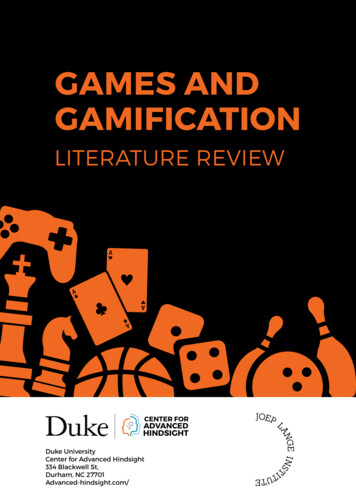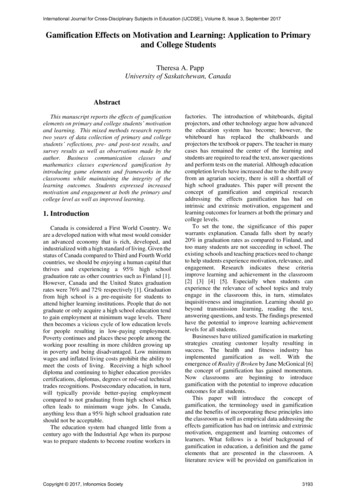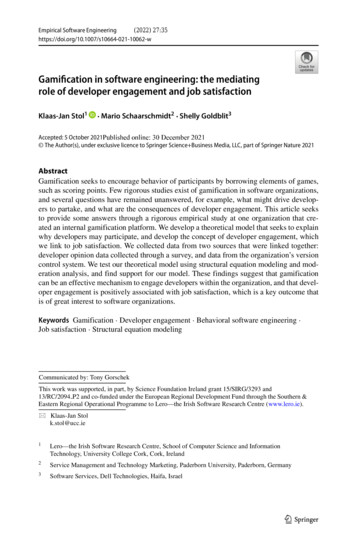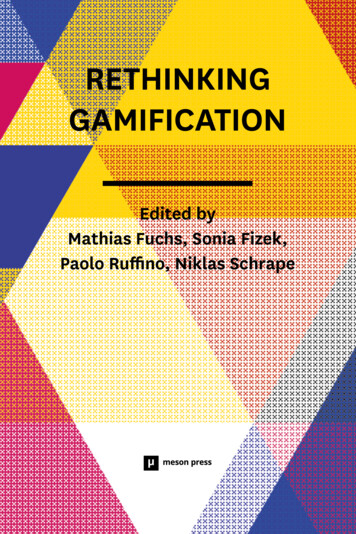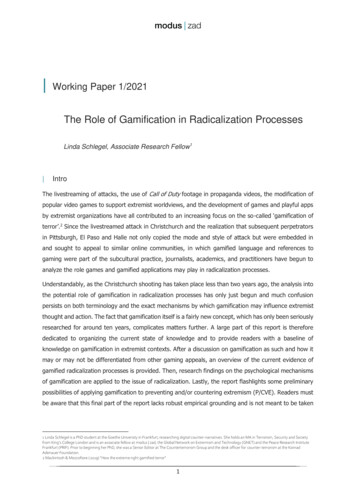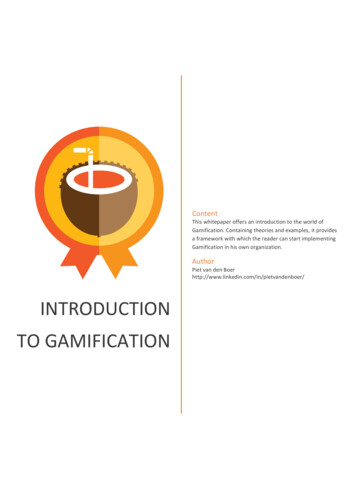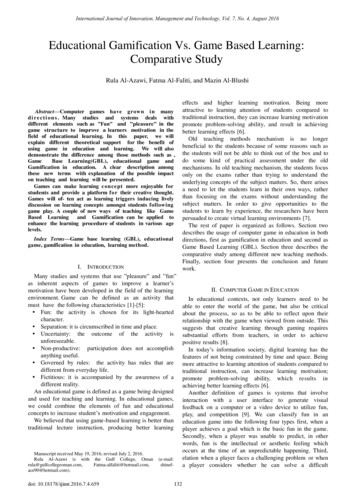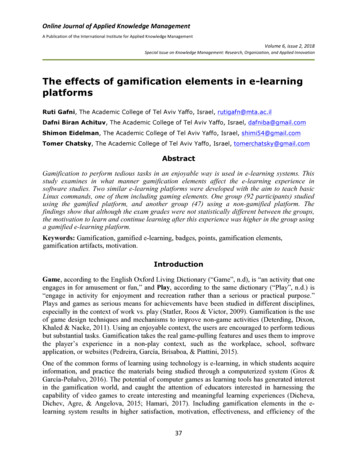
Transcription
Online Journal of Applied Knowledge ManagementA Publication of the International Institute for Applied Knowledge ManagementVolume 6, issue 2, 2018Special Issue on Knowledge Management: Research, Organization, and Applied InnovationThe effects of gamification elements in e-learningplatformsRuti Gafni, The Academic College of Tel Aviv Yaffo, Israel, rutigafn@mta.ac.ilDafni Biran Achituv, The Academic College of Tel Aviv Yaffo, Israel, dafniba@gmail.comShimon Eidelman, The Academic College of Tel Aviv Yaffo, Israel, shimi54@gmail.comTomer Chatsky, The Academic College of Tel Aviv Yaffo, Israel, tomerchatsky@gmail.comAbstractGamification to perform tedious tasks in an enjoyable way is used in e-learning systems. Thisstudy examines in what manner gamification elements affect the e-learning experience insoftware studies. Two similar e-learning platforms were developed with the aim to teach basicLinux commands, one of them including gaming elements. One group (92 participants) studiedusing the gamified platform, and another group (47) using a non-gamified platform. Thefindings show that although the exam grades were not statistically different between the groups,the motivation to learn and continue learning after this experience was higher in the group usinga gamified e-learning platform.Keywords: Gamification, gamified e-learning, badges, points, gamification elements,gamification artifacts, motivation.IntroductionGame, according to the English Oxford Living Dictionary (“Game”, n.d), is “an activity that oneengages in for amusement or fun,” and Play, according to the same dictionary (“Play”, n.d.) is“engage in activity for enjoyment and recreation rather than a serious or practical purpose.”Plays and games as serious means for achievements have been studied in different disciplines,especially in the context of work vs. play (Statler, Roos & Victor, 2009). Gamification is the useof game design techniques and mechanisms to improve non-game activities (Deterding, Dixon,Khaled & Nacke, 2011). Using an enjoyable context, the users are encouraged to perform tediousbut substantial tasks. Gamification takes the real game-pulling features and uses them to improvethe player’s experience in a non-play context, such as the workplace, school, softwareapplication, or websites (Pedreira, García, Brisaboa, & Piattini, 2015).One of the common forms of learning using technology is e-learning, in which students acquireinformation, and practice the materials being studied through a computerized system (Gros &García-Peñalvo, 2016). The potential of computer games as learning tools has generated interestin the gamification world, and caught the attention of educators interested in harnessing thecapability of video games to create interesting and meaningful learning experiences (Dicheva,Dichev, Agre, & Angelova, 2015; Hamari, 2017). Including gamification elements in the elearning system results in higher satisfaction, motivation, effectiveness, and efficiency of the37
Online Journal of Applied Knowledge ManagementA Publication of the International Institute for Applied Knowledge ManagementVolume 6, issue 2, 2018Special Issue on Knowledge Management: Research, Organization, and Applied Innovationparticipants, especially the Y-generation students, who grew in an age of interactive media andvideo games (Bosworth, 2012; Glover, 2013; Poole, Kemp, Patterson, & Williams, 2014).Gamification is largely used in applications of languages acquisition, finding the positive effecton vocabulary development (Alemi, 2010; Meihami, Varmaghani & Meihami, 2013), whileenhancing and stimulating the learning process (Gafni, Biran-Achituv & Rachmani, 2017).Students using computer games for learning are more active, feel more involved and morechallenged than in traditional lectures (Grimley, Green, Nilsen, Thompson, & Tomes, 2011).Moreover, gamification enables students to receive constant feedback on their progress in theclassroom and provide information about their completed activity (Kapp, 2012). In order toinclude gamification in an e-learning environment, the system has to include gamificationelements, which can appear in a variety of forms, such as points, levels, badges, medals,scoreboards and virtual goods (Dicheva et al., 2015). The role of these elements is to make usersenjoy the interface in different ways, so that the user can play as much as possible, while performtasks that would not been achieved in any other way (Hanus & Fox, 2015).The aim of this study is to examine in what manner adding gamification elements to an elearning platform affects the e-learning experience in software studies. In order to explore this,an experimental design with a random assignment of participants into two groups (gamifiedplatform learning group vs. non-gamified platform group) was conducted. Two similar elearning platforms were developed, with the aim to teach basic Linux commands, one of themincluding some gaming elements. After concluding the learning session, the students performedan exam, in order to check the understanding of the taught topics. The same exam was performedin both platforms. Finally, the students had to complete a survey. The findings show thatalthough the exam grades were not statistically different between the two groups, the motivationto learn and to continue learning after this experience were higher in the group using a gamifiede-learning environment. The remainder of this paper is organized as follows. First, a theoreticalbackground of gamification is provided. Then, the research questions are explained. Themethodology section describes the manner this study was conducted. Thereafter, the results aredisplayed, and finally the discussion and conclusions are presented.Theoretical BackgroundThe use of gamification in order to perform non-game activities has been growing in the lastdecade. Researchers are still trying to decode this instrument, in order to understand the pros andcons of using elements of gamification, finding diverse and sometimes contradicting results.Statler, Roos, and Victor (2009) stated that the potential impact of “playing” work activities inorganizations can benefit the organization, by involving imagination, fun, emotions andcognitive skills of the individual. Organizations cope with the apparently contradiction betweenproductivity and efficiency, vs. creativity and deep learning goals. However, there is no conflictbetween these organizational goals, and they should coexist harmoniously, side by side (Kolb &Kolb, 2010). Different aspects of gamification have been studied in recent years:38
Online Journal of Applied Knowledge ManagementA Publication of the International Institute for Applied Knowledge ManagementVolume 6, issue 2, 2018Special Issue on Knowledge Management: Research, Organization, and Applied InnovationFirst Impression of the SystemUsers’ perception and evaluation of websites, applications, and information systems aredetermined before being used and experienced, by their first impression, which involves content,usability, and aesthetics. Thielsch, Blotenberg, and Jaron (2013) stated that aesthetics is the mostimportant component for the first impression, while after experiencing the use of the system,content is the most important for continuing using it, especially when the users are asked to beactive. Kapp (2012) included the ‘game thinking’ as one of the main building blocks ofgamification, and stated that “using game-based mechanics, aesthetics, and game thinking toengage people, motivate action, promote learning, and solve problems” (p. 10).Gamification ElementsA large range of gamification elements exists. These are called also gamification artifacts ormechanics. The most common are the following (Dicheva et al., 2015):(1) Points - are used to reward users through multiple dimensions and different categories (daRocha, Gomes, & de Melo, 2016).(2) Levels - indicate that the user has reached a certain goal or completed a task. In computergames, the players complete different tasks, and thus, can progress in the game. The levels aredesigned to challenge the players, thereby creating pleasure and a desire to continue playing thegame (Goehle, 2013).(3) Badges, trophies, and medals – express external recognition that the user has reached newlevels and has succeeded in the challenges. This kind of rewards stimulate the users and theirdesire to complete the challenges (da Rocha et al., 2016), providing pleasure and interest (Antin& Churchill, 2011).(4) Ranking, leaderboards, and scoreboards – These elements show users’ relative positioncompared to others, which are commonly used to show and manage users achievements, in orderto use competition as an incentive for behavior, thus, improving motivation (Cagiltay, Ozcelik,& Ozcelik, 2015).(5) Virtual Goods – are nonphysical and intangible objects that can be acquired throughaccumulated points. Virtual goods create incentives to get more points, complete tasks, andchallenges. In addition, they allow personalization of the reward according to the type of user(da Rocha et al., 2016). It is very common to use virtual currencies in various situations,including for trading products, points for raising status, and prestige (da Rocha et al., 2016).Gamification and MotivationMotivation is composed of processes provoking, directing, and preserving human behaviortoward a particular goal. People have different needs and desires: rewards, status, achievements,self-expression, and competition (Richter, Raban, & Rafaeli, 2015). Researchers distinctbetween two different kinds of motivation: intrinsic and extrinsic motivations (Levesque, 2011).Intrinsic motivation is based on internal interests and willingness to engage to a specific activity,with no external factors involved, because the specific activity is inherently interesting orenjoyable (Ryan & Deci, 2000). According to Kolb and Kolb (2010), individuals who are39
Online Journal of Applied Knowledge ManagementA Publication of the International Institute for Applied Knowledge ManagementVolume 6, issue 2, 2018Special Issue on Knowledge Management: Research, Organization, and Applied Innovationengaged in experiential learning are intrinsically motivated. Intrinsic motivation is veryimportant, but most of the activities people need to perform are not intrinsically motivating(Ryan & Deci, 2000). Therefore, it is important to add some extrinsic motivations. Extrinsicmotivation is based on external factors such as rewards, either tangible, or intangible (Deci,Koestner, & Ryan, 2001). Both intrinsic and extrinsic motivations are combined in the use ofgamification. There has been a significant increase in the use of game elements in non-gameapplications, in order to increase user engagement and motivation (da Rocha et al., 2016; Richteret al., 2015), which have different roles, for example:(1) Prizes - tangible or intangible, implemented in points, trophies, medals, and virtual goods,are granted after certain achievements.(2) Status and reputation - most people need feelings like fame, prestige, attention,appreciation and respect from others. To achieve this, they need to engage in certain activities.These are implemented in collecting badges, levels, ranking, profiles and leaderboards.(3) Competition – the desire to be the winner can increase performance. High levels ofmotivation can be achieved implementing ranking, scoreboards and leaderboards.The gamification of e-learning platforms has the potential to increase motivation among studentsby learning in new ways and enjoying tedious and boring tasks (Hanus & Fox, 2015). To achievethis potential effectiveness, great effort is required to design, develop, and create a motivatingexperience (Domínguez et al., 2013). Some studies have been conducted to explore intrinsic andextrinsic motivations when using reward platforms. Some meta-analyses (Deci et al., 2001;Richter et al., 2015) suggested that rewards that are designed to increase extrinsic motivationundermine the intrinsic one. Thus, having negative impact on learners. On the one hand,awarding prizes for tasks that already have interest reduces internal motivation. On the otherhand, incentives given for boring tasks have increased internal motivation (Cameron, Banko, &Pierce, 2001). Therefore, studies recommend creating systems of gamification containing acombination of both external and internal incentives that will maintain the level of interest andlong-term user engagement (Cameron et al., 2001; Ryan & Deci, 2000).Learning Through GamificationLearning is a holistic and circular process, which includes experiencing, reflecting, thinking, andacting accordingly (Kolb & Kolb, 2009). Reworking and relearning of knowledge, is achievedthrough experience and feedback. Learning needs time and space to be done (Kolb & Kolb,2010). Experiencing learning in an enjoyable and competitive way can enhance the engagementof the learner to the process, due to the feelings of pleasure, and to the stimulation to reflect(Kolb & Kolb, 2010). Including gamification elements in the learning process can benefit thelearner’s experience. There have been several studies of gamification at school and universitieswith an emphasis on the gamification elements’ influence including rewarding points andbadges.Rewarding pointsThe use of rewarding points affects the studying process in the following ways:(1) Points raise internal motivation (Mekler, Brühlmann, Opwis, & Tuch, 2013).40
Online Journal of Applied Knowledge ManagementA Publication of the International Institute for Applied Knowledge ManagementVolume 6, issue 2, 2018Special Issue on Knowledge Management: Research, Organization, and Applied Innovation(2) Because points are rewarded according to achievements, they can be perceived as providingfeedback on students’ progress, which is helpful and encourages continued learning (Mekler etal., 2013).(3) Rewarding points increases the participants’ involvement in learning with a software game(Li, Dong, Untch, & Chastee, 2013). However, points given for participation instead of pointsfor achievements, have no effect on the quality of the tasks performed (Lister, 2015).BadgesPrior studies found that the majority of the students invested efforts in the studying activities, inorder to achieve the goals imposed by levels and stages (Goehle, 2013). The use of badges hasseveral positive aspects, such as:(1) Encouraging user’s activity and thus increasing participation (Denny, 2013; Grant & Betts,2013).(2) Leveraging the motivation of the users (Haaranen, Ihantola, Hakulinen, & Korhonen, 2014),their engagement with the system (Hakulinen, Auvinen, & Korhonen, 2015; Luo, Yang, &Meinel, 2015) and their achievements (Antin & Churchill, 2011; da Rocha et al., 2016).(3) Feeling satisfaction for completing tasks (Goehle, 2013).In contrary, the use of badges can have other effects:(1) If the achievements that award the badges are too difficult, they can cause frustration (Luo etal., 2015).(2) Some students are indifferent to badges (Haaranen et al., 2014).(3) Rewards are usually effective only in the short term. In the long term, users lose interest inrewards, affecting motivation. As long as they want to ensure long-term motivation, users shouldbe encouraged to increase internal motivation rather than external motivation (Luo et al., 2015).(4) Student’s motivation depends on their prior knowledge: low-performing students aremotivated by badges granted for their participation, while high-performing students aremotivated by post-proficiency badges (Abramovich, Schunn, & Higashi, 2013).(5) Awarding prizes for interesting tasks, reduces internal motivation. However, incentives givenfor boring tasks increase internal motivation (Cameron et al., 2001).As a result, many educational software platforms have been developed in order to create an easy,fun, and challenging way to study, using some of the mentioned gamification elements. In orderfor a gamification platform to work successfully, it must be design with a clear purpose andinstructions, developing several ways to solve the tasks, in order to adjust to different levels ofknowledge, and to include hints to guide the users (Dong et al., 2012).Research QuestionsIn order to find out how gamification contributes to the study of software, three researchquestions were defined:41
Online Journal of Applied Knowledge ManagementA Publication of the International Institute for Applied Knowledge ManagementVolume 6, issue 2, 2018Special Issue on Knowledge Management: Research, Organization, and Applied InnovationRQ1: How do gamification elements influence intrinsic and extrinsic motivation of softwarelearners?In this paper, gamification elements examined are badges, points, and profile, which representsthe levels of the user's progress. According to the papers reviewed in Lister (2015)’s metaanalysis, badges, points, and levels are the most common elements of gamification. Badgesincrease extrinsic motivation but might have both positive (Hakulinen et al., 2015; Luo et al.,2015) and negative influence on intrinsic motivation (Cameron et al., 2001; Luo et al., 2015).Points have positive influence on internal motivation (Mekler et al., 2013). As levels aredesigned to increase interest and enjoyment (Goehle, 2013) they are supposed to have positiveinfluence on intrinsic motivation.RQ2: Do gamification elements enable better understanding of software studies?Understanding of software studies is examined both by an exam the participants performed inthis research, and by data, which was collected after the participants’ experienced with the elearning platform, concerning their perceived understanding of the material. Prior research showsthat gamification has a stimulation effect on learners (Gafni et al., 2017). Rewards raise extrinsicmotivation of learners to spend more time learning and answering more questions, withoutreducing their quality (Denny, 2013). According to some studies, students that get more rewardshave better performances by average (da Rocha et al., 2016). On the other hand, gamifiedcourses might show lower grades as an effect of intrinsic motivation reduction (Hanus & Fox,2015).RQ3: Is a gamified e-learning platform the preferred studying environment for students?Participants were asked to check their preference of various studying means: watching videotutorials, using gamified applications, learning with private teachers, learning from the Internet,learning in traditional face-to-face classes or by reading a book. Using an enjoyable context, theusers are encouraged to perform tedious but substantial tasks (Deterding et al., 2011). However,is it the preferred means for the students? Does the experience of learning with a gamifiedplatform and having a positive experience change the way students want to study?MethodologyThe research methodology included two stages.Stage 1: In order to test the research hypotheses, an experimental design with a randomassignment of participants into two groups (gamified platform learning group vs. non-gamifiedplatform group) was conducted. Post-test measurement of the dependent variables: exam gradesand various aspects of subjective perceptions of the learning process.The targeted population were individuals who learnt software during their academic studies orby self -learning. Because of the specific population, for which no list of participants exists, thesample was gathered using nonprobability snowball sampling (Baltar & Brunet, 2012; Noy,2008). Nevertheless, the invitation to participate was not distributed in first place to individuals,or to familiar known persons, but to specific forums and groups according to the kind of42
Online Journal of Applied Knowledge ManagementA Publication of the International Institute for Applied Knowledge ManagementVolume 6, issue 2, 2018Special Issue on Knowledge Management: Research, Organization, and Applied Innovationpopulation needed, and those relevant populations were asked to follow the invitations further.The first wave of invitations to participate was distributed through Facebook and WhatsAppsocial networks, to unknown students who study software in universities, academic andtechnology colleges, as well as to software professional groups. Those who accepted theinvitation, were randomly divided into the two groups, in order to have two third of theparticipants performing the gamified course, and one third performing the non-gamified course.Two similar e-learning platforms were developed, using the WIX environment (Free websitebuilder: https://www.wix.com/), and a Linux server based on Amazon’s Web Services (AWS)cloud, in order to teach basic commands in Linux operation system. Both platforms taught thesame contents, and had a same exam at the end, in order to evaluate the learning results. Bothgroups had a concrete time framework to perform their learning process, and both use thecomputer as the space for learning, according to Kolb and Kolb theory (2010). The “regular” elearning platform consisted of information and explanations about the Linux commands, andexamples on how to use them. The “gamified” e-learning platform included the same content asthe “regular” one, but with a gamified framework, including gamification elements likeadvancing through levels, getting badges and points, and updating the user’s profile according tothe achievements (Figure 1). Each step entitled the learner to use the commands taught, in orderto find passwords hidden in the Linux server. Using the found passwords, the users couldadvance to the next level. Using the “gamified” e-learning platform, the students go through allstages in the learning cycle of Kolb and Kolb (2009): they experienced the activity of learning inan enjoyable way, through the gamification, they received feedback, in shape of points, badgesand changes in profiles, which contributed to their reflection on their learning progress, thinkingabout the next step they have to perform, and then deciding how to act, in order to get to the nextlevel.Gamification ElementsProfilesPointsBadgesLearning StageInitialAdvancedProfessionalFigure 1: Gamification Elements Used vs. Learning Stage in the ExperimentsAfter finishing the learning phase, the participants, in both platforms, were asked to take anexam, which evaluated their understanding, giving them a grade, according to the correctanswers. The goal of the exam was to find whether there are differences in the understanding ofthe materials taught in both platforms. After finishing the exam, each participant received asurvey, in order to examine the user’s experience using the platform. The basis of the instrumentsurvey was the same for both groups. The survey was composed from some basic demographicquestions, some questions regarding the perception of the participants on the difficulty of the43
Online Journal of Applied Knowledge ManagementA Publication of the International Institute for Applied Knowledge ManagementVolume 6, issue 2, 2018Special Issue on Knowledge Management: Research, Organization, and Applied Innovationcourse and the exam, as well as the level of interest and willingness to study the subject usingthe application. The answers to these questions were defined using a 5-point Likert type scale,defining level of interest/difficulties/satisfaction from 1 (not at all) to 5 (very much). The thirdpart of the survey asked for the preferred means for learning, where a list of means wasdisplayed, and each participant could check one answer or more.Stage 2: In order to add more in-depth understanding of using the gamification elements, thesecond stage focused on the participants of the gamification platform group only. The group thatparticipated in the gamified e-learning platform had to answer a second part of the survey, inwhich the experience with each gamification element was examined. This survey, which wasanswered only by the participants who performed the gamified course, asked about theirperceptions to the effects of the different gamification elements on the learning motivation.These answers to these questions were defined using a 5-point Likert type scale, from 1 – not atall to 5 – very much. All the ordinal Likert type scales were balanced (i.e. the distance betweeneach value of the scale is the same), so it is acceptable to use the mean to represent the centraltendency of the distribution, as well to perform t-tests, correlations, and other parametricstatistics (Norman, 2010). Such statistics are presented in the tables of the Results section below.The surveys, elaborated using Google Forms, enabled keeping the anonymity of the participants.The responses to the survey were analyzed using IBM Statistical Package for Scoail Sciences(SPSS ), version 25.ResultsResults from the experiments follow the two stages discussed above.Stage 1 results:The data was gathered from the surveys that the participants filled in, after using one of the elearning platforms and performing the exam. Table 1 shows the descriptive statistics of the studyparticipants. Most of the participants in both groups were male students.Table 1. Descriptive Statistics of the Study Participants (N 139)Demographics VariableNo. of 47Gender (%)MaleFemale74%26%70%30%Academic Level (%)High schoolNon-academic studiesUndergraduate studiesGraduate 4
Online Journal of Applied Knowledge ManagementA Publication of the International Institute for Applied Knowledge ManagementVolume 6, issue 2, 2018Special Issue on Knowledge Management: Research, Organization, and Applied InnovationIn order to examine RQ2, the same exam was performed by all the participants in both groups.Table 2. Exam and Perceived Difficulty (N 139)Demographics VariableExam grade (Out of 100) (STD )Degree of understanding (1-5)GamifiedPlatform (n1 92)Mean85.33 (11.97)3.87Perceived difficulty of the exam (1-5)2.80Previous knowledge in programming (1-5)2.65Percentage1 – 0%2 – 3.3%3 – 21.7%4 – 56.5%5 – 18.5%1 – 3.3%2 – 35.9%3 – 39.1%4 – 19.6%5 – 2.2%1 – 19.6%2 – 14.1%3 – 48.9%4 – 16.3%5 – 1.1%Non-GamifiedPlatform (n2 49)Mean81.15 (21.07)4.002.532.49Percentage1 – 0%2 – 4.3%3 – 21.3%4 – 42.6%5 – 31.9%1 – 6.4%2 – 44.7%3 – 34.0%4 – 14.9%5 – 0%1 – 25.5%2 – 27.7%3 – 23.4%4 – 19.1%5 – 4.3%Table 2 summarizes the mean and standard deviation of the exam grades. Moreover, Table 2shows the degree of understanding the learning materials and the perceived difficulty of theexam by the participants. These questions were answered using the 5-point Likert type scale forthe degree of agreement by the participants (from 1- not at all to 5 – very much). The tableshows the mean, and the percentage of each variable (1-5). As can be seen in Table 1, theparticipants had similar background and previous knowledge. Although the exam grade of thegamified application is higher than the non-game, and its standard deviation is smaller, t-testsperformed on these results show no statistical differences (p 0.05) between the groups. Nodifferences were found between the degree of understanding and the difficulty level, between thegroups as well, although the non-gamified group perceived the exam as being easier.Nevertheless, the mean of the exam grade for the non-gamified group was lower (See Table 2).Table 3. Differences Between the Platforms (N 139)VariableGamifiedPlatform(n1 92)Mean (std)Non-GamifiedPlatform(n2 49)Mean (std)t-testp value(sig.)First impression of the applicationLevel of interestDesire to continue learning LinuxDesire to learn other coursesFeeling lack of stimulus during the studies4.07 (0.71)3.83 (0.96)3.75 (0.92)4.36 (0.79)0.04 (0.20)3.36 (1.03)3.06 (1.09)2.96 (1.30)2.81 (1.37)0.53 000***.000***.000**** p 0.05, ** p 0.01, *** p 0.00145
Online Journal of Applied Knowledge ManagementA Publication of the International Institute for Applied Knowledge ManagementVolume 6, issue 2, 2018Special Issue on Knowledge Management: Research, Organization, and Applied InnovationThe participants were asked a number of questions in order to evaluate the effect of integrationof gamification elements in the learning environment, with the purpose to understand RQ3. Ttests were performed in order to identify differences between the groups. Table 3 shows themeans and standard deviations of the variables examined, as well as the t-tests of the statisticalsignificant differences. In this analsyis, all measures including: first impression of theapplication, level of interest, desire to continue learning linux, desire to learn other courses, andfeeling lack of stimulus during the studies were found to be significant between the two groups(p 0.001).Correlations were performed between independent variable (Gamified platform: game or nongame platform) and the dependent variables - exam grades and various aspects of subjectiveperceptions of the learning process. Table 4 shows the correlations found. As shown, there is nocorrelation between the grade the participants received in the exam, and the platform, but therewas a positive correlation between the level of interest in the materials and the exam grade.Table 4. Correlation Matrix of Dependent and Independent Variables (N 139)VariableGamifiedplatformExam GradeGamifiedplatformExamGrade-0.126sig 0.138-First impressionof theapplicationLevel of interestFirstimpressionof theapplication0.374***sig 0.0000.051sig 0.554-Level ofinterest0.340***sig 0.0000.298***sig 0.0000.287**sig 0.001-Desire tocontinuelearning LinuxDesire to learnother coursesFeeling lack ofstimulus* p 0.05, ** p 0.01, *** p 0.001Desire tocontinuelearningLinux0.334***sig 0.0000.214*sig 0.0110.336***sig 0.000Desire tolearn othercoursesFeelinglack ofstimulus0.563***sig 0.0000.132sig 0.120.557***sig 0.000-0.569***sig 0.000-0.225**sig 0.008-0.378***sig 0.0000.526***sig 0.000-0.462***sig 0.0
Keywords: Gamification, gamified e-learning, badges, points, gamification elements, gamification artifacts, motivation. Introduction Game, according to the English Oxford Living Dictionary (“Game”, n.d), is “an activity that one engages in for amusement or fun,” and
